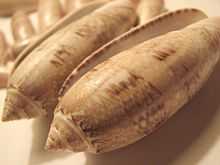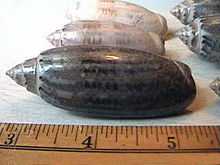Lettered olive
| Lettered olive | |
|---|---|
| | |
| Shell of the lettered olive | |
| Scientific classification | |
| Kingdom: | Animalia |
| Phylum: | Mollusca |
| Class: | Gastropoda |
| Order: | Neogastropoda |
| (unranked): | clade Caenogastropoda clade Hypsogastropoda clade Neogastropoda |
| Superfamily: | Olivoidea |
| Family: | Olividae |
| Subfamily: | Olivinae |
| Genus: | Oliva |
| Species: | O. sayana |
| Binomial name | |
| Oliva sayana Ravenel, 1834 | |
| Synonyms[1] | |
|
Oliva litterata Lamarck, 1811 | |
The lettered olive, Oliva sayana, is a species of large predatory sea snail, a marine gastropod mollusc in the family Olividae, the olive shells, olive snails, or olives.
Subspecies
Oliva sayana contains the following subspecies:[2]
- Oliva sayana sarasotensis Petuch & Sargent, 1986
- Oliva sayana sayana Ravenel, 1834
- Oliva sayana texana Petuch & Sargent, 1986
Distribution
The species' range is from North Carolina to Florida and the Gulf states of North America, including Louisiana and Texas; It also occurs in Mexico, including Campeche State, Yucatán State and Quintana Roo,[1] and may also occur in Brazil.
Habitat
The lettered olive typically lives in near-shore waters, on shallow sand flats near inlets. The empty shell is occasionally, or sometimes commonly, washed up onto ocean beaches.


Shell description
The shell of this species can be about 6 cm (2½ in) long (maximum reported size reaches 9.1 cm[1]). It is a smooth, shiny, cylindrical-shaped shell with a short spire. The aperture is narrow and extending almost the length of shell, continuing around the bottom and ending in a notch on the other side. The suture is V-cut and deep. The lower part of the whorl is just above where the suture extends outward and then at a sharp shoulder drops into the suture.
The shell coloration can vary from cream to a greyish exterior with reddish-brown zigzag markings. The common name of this species is derived from the darker surface markings that sometimes resemble letters.
Life habits
This olive, like all olives, is a carnivore: it captures bivalves and small crustaceans with its foot and takes them below the sand surface to digest.
Its presence is sometimes detected at very low tides by the trails it leaves when it crawls below the surface on semi-exposed sand flats.
Females lay floating, round egg capsules that are often found in beach drift. Young are free swimming.
Human use
Colonists and early Native Americans made jewelry from these shells.
The lettered olive is the state shell of South Carolina.
References
- ↑ 1.0 1.1 1.2 Malacolog 4.1.1: Western Atlantic Mollusk Species Database. Retrieved April 2010.
- ↑ Oliva sayana Ravenel, 1834. Retrieved through: World Register of Marine Species on 26 April 2010.
| Wikimedia Commons has media related to Oliva sayana. |